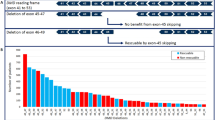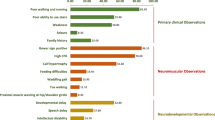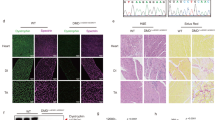Abstract
Exon skipping therapy has recently received attention for its ability to convert the phenotype of lethal Duchenne muscular dystrophy (DMD) to a more benign form, Becker muscular dystrophy (BMD), by correcting the open reading frame. This therapy has mainly focused on a hot-spot (exons 45–55) mutation in the DMD gene. Exon skipping of an entire stretch of exons 45–55 is an approach applicable to 46.9% of DMD patients. However, the resulting phenotype is not yet fully understood. Here we examined the clinical profiles of 24 patients with BMD resulting from deletions starting at exon 45. The Δ45–55 group ranged in age from 2 to 87 years; no mortality was observed, and one patient was ambulatory at 79 years of age. The age at which patients became wheelchair-bound in the Δ45–48 group (18–88 years old) was approximately 50 years. Cardiomyopathy was well controlled by pharmaceuticals in both deletion groups. In contrast, the Δ45–47 and Δ45–49 groups exhibited more severe phenotypes than those with other mutations: the age at which patients in the Δ45–49 group became wheelchair-bound was around 30–40 years. Our study shows that clinical severity differs between each hot-spot deletion.
Similar content being viewed by others
Log in or create a free account to read this content
Gain free access to this article, as well as selected content from this journal and more on nature.com
or
References
Hoffman, E. P., Brown, R. H. Jr. & Kunkel, L. M. Dystrophin: the protein product of the Duchenne muscular dystrophy locus. Cell 51, 919–928 (1987).
Monaco, A. P., Bertelson, C. J., Liechti-Gallati, S., Moser, H. & Kunkel, L. M. An explanation for the phenotype differences between patients bearing partial deletions of the DMD locus. Genomics 2, 90–95 (1988).
Aartsma-Rus, A. & van Ommen, G. J. Antisense-mediated exon skipping: a versatile tool with therapeutic and research applications. RNA 13, 1609–1624 (2007).
Tuffy-Giraud, S., Beroud, C., Leturcq, F., Yaou, R. B., Hamroun, D., Michel-Calemard, L. et al. Genotype-phnotype analysis in 2405 patients with a dystrophinopathy using UMD-DMD database: a model of nationwide knowledge-base. Hum. Mutat. 30, 934–945 (2009).
Nicolas, A., Lucchetti-Miganeh, C., Ben Yaou, R., Laplan, J. C., Chelly, J., Leturcq, F. et al. Assessment of the structural and functional impact on in-frame mutations of the DMD gene, using the tools included in the eDystrophin online database. Orphanet J. Rare Dis. 7, 45 (2012).
Koenig, M., Beggs, A. H., Moyer, M., Scherpf, S., Heindrich, K., Bettecken, T. et al. The molecular basis for Duchenne versus Becker muscular dystrophy: correlation of severity with type of deletion. Am. J. Hum. Genet. 45, 498–506 (1989).
Nakamura, A., Yoshida, K., Fukushima, K., Ueda, H., Urasawa, N., Koyama, J. et al. Follow-up of three patients with a large in-frame deletion of exons 45–55 in the Duchenne muscular dystrophy (DMD) gene. J. Clin. Neurosci. 15, 757–763 (2008).
Béroud, C., Tuffery-Giraud, S., Matsuo, M., Hamroun, D., Humbertclaude, V., Monnier, N. et al. Multiexon skipping leading to an artificial DMD protein lacking amino acids from exons 45 through 55 could rescue up to 63% of patients with Duchenne muscular dystrophy. Hum. Mutat. 28, 196–202 (2007).
Taglia, A., Petillo, R., D'Ambrosio, P., Picillo, E., Torella, A., Orsini, C. et al. Clinical features of patients with dystrophinopathy sharing the 45-55 exon deletion of DMD gene. Acta Myol. 34, 9–13 (2015).
Nakamura, A. & Takeda, S. Exon-skipping therapy for Duchenne muscular dystrophy. Neuropathol. 29, 494–501 (2009).
Aoki, Y., Yokota, T., Nagata, T., Nakamura, A., Tanihata, J., Saito, T. et al. Bodywide skipping of exons 45–55 in dystrophic mdx52 mice by systemic antisense delivery. Proc. Natl Acad. Sci. USA 34, 13763–13768 (2012).
Nicolas, A., Raguénès-Nicol, C., Ben Yaou, R., Ameziane-Le Hir, S., Chéron, A., Vié, V. et al. Becker muscular dystrophy severity is linked to the structure of dystrophin. Hum. Mol. Genet 24, 1267–1279 (2015).
Findlay, A. R., Wein, N., Kaminoh, Y., Taylor, L. E., Dunn, D. M., Mendell, J. R. et al. Clinical phenotypes as predictors of the outcome of skipping around DMD exon 45. Ann. Neurol. 77, 668–674 (2015).
Ousterout, D. G., Kabadi, A. M., Thakore, P. I., Majoros, W. H., Reddy, T. E. & Gersbach, C. A. Multiplex CRISPR/Cas9-based genome editing for correction of dystrophin mutations that cause Duchenne muscular dystrophy. Nat. Commun. 18, 6244 (2015).
Tasaki, N., Yoshida, K., Haruta, S. I., Kouno, H., Ichinose, H., Fujimoto, Y. et al. X-linked dilated cardiomyopathy with a large hot-spot deletion in the dystrophin gene. Intern. Med. 40, 1215–1221 (2001).
Yazaki, M., Yoshida, Y., Nakamura, A., Koyama, J., Nanba, T., Ohori, N. et al. Clinical characteristics of aged Becker muscular dystrophy wit onset after 30 years. Eur. Neurol. 42, 145–149 (1999).
Acknowledgements
This study was supported by an Intramural Research Grant (26-6) for Neurological and Psychiatric Disorders of the National Center of Neurology and Psychiatry (to AN). We thank Editage (www.editage.jp) for English language editing.
Author information
Authors and Affiliations
Corresponding author
Ethics declarations
Competing interests
The authors declare no conflict of interest.
Rights and permissions
About this article
Cite this article
Nakamura, A., Shiba, N., Miyazaki, D. et al. Comparison of the phenotypes of patients harboring in-frame deletions starting at exon 45 in the Duchenne muscular dystrophy gene indicates potential for the development of exon skipping therapy. J Hum Genet 62, 459–463 (2017). https://doi.org/10.1038/jhg.2016.152
Received:
Revised:
Accepted:
Published:
Issue date:
DOI: https://doi.org/10.1038/jhg.2016.152
This article is cited by
-
Deletion of exons 45 to 55 in the DMD gene: from the therapeutic perspective to the in vitro model
Skeletal Muscle (2024)
-
Cell Therapy Strategies on Duchenne Muscular Dystrophy: A Systematic Review of Clinical Applications
Stem Cell Reviews and Reports (2024)
-
Therapeutic approaches for Duchenne muscular dystrophy
Nature Reviews Drug Discovery (2023)



